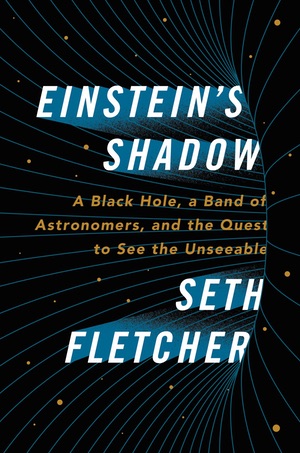Review: Einstein’s Shadowby Jeff Foust
|
| Like a black hole’s gravitational field, Doeleman gradually, but inexorably, got pulled into the effort. “Without quite realizing what he was doing, Shep started building a team,” Fletcher writes. |
But even smaller efforts are still complex. Most people outside of astronomy have not heard of the Event Horizon Telescope despite its ambitious goal: to take the first image of a black hole. The project has a far smaller budget than megaprojects like LIGO and JWST: tens of millions of dollars, versus billions. It largely makes use of existing millimeter-wave observatories scattered around the world, networked to create a virtual telescope the size of the Earth.
It is, though, fraught with many of the same scientific, technical, and programmatic challenges of larger projects. In Einstein’s Shadow, Seth Fletcher, an editor at Scientific American, offers an insider’s view of the development of the Event Horizon Telescope as its backers dealt with those series of challenges.
The central figure in Einstein’s Shadow is Sheperd “Shep” Doeleman, an astronomer who finds his way into millimeter-wave astronomy after a bit of circuitous career path, including almost flunking out of graduate school at MIT. That frequency band, astronomers found, had the best chance of piercing the gas and dust surrounding the core of the Milky Way, offering the potential to directly image Sagittarius A*, the supermassive black hole at its core.
That would require, though, combining individual observatories into a virtual telescope, using a technique called very long baseline interferometry, or VLBI. Like a black hole’s gravitational field, Doeleman gradually, but inexorably, got pulled into the effort. “Without quite realizing what he was doing, Shep started building a team,” Fletcher writes of the early efforts to assemble a group of astronomers and telescopes to achieve that goal of imaging a black hole.
Part of the effort described in the book is a scientific one, including development of the technology needed to simultaneously observe from multiple telescopes and then be able to combine the data. But the story described in the book is also very much one of the people involved and the difficulties they faced in putting together the Event Horizon Telescope, from raising funding to getting time on telescopes to cooperation—and occasional distrust—among collaborators. Doeleman is portrayed as something of a reluctant leader who might be more comfortable building instruments, but he’s also worried that others might come in and take control of the project that represents his professional career. And, Fletcher writes, they were also thinking of who would get the credit, and possibly the Nobel, if they succeeded.
| But, perhaps, that incomplete ending is more reflective of how science works. |
That focus on both the science, and the process of doing the science, is fascinating, but it’s also incomplete. The book concludes with an observing campaign in the spring of 2017 that was the first test of the full-fledged Event Horizon Telescope, one that demonstrated its capabilities but also uncovered technical issues with some aspects of it. Analysis of that data is still in progress, along with observations taken earlier this year. The project, in its latest status update dated May 1, noted that VLBI “has been called the ‘ultimate in delayed gratification’ among astronomers.” In other words, no results yet.
That delayed gratification might have been too much for the author or the publisher, who went ahead with this book without knowing whether the telescope is actually able to resolve the block hole in our galaxy’s core. That’s not the only thing that makes this book seem incomplete, though. There’s a surprising lack of images—of the people involved, of the observatories used, or even of illustrations of black holes—in the book. There are a handful of diagrams of some of the scientific concepts mentioned in the book, but these line drawings are not a substitute for some of the richer imagery of the science and the people who made it possible.
But, perhaps, that incomplete ending is more reflective of how science works. LIGO didn’t end with the first gravitational wave detection; its work only got started. Likewise, the journey of JWST won’t end with its eventual launch but with the science that it will produce in the years to follow. The Event Horizon Telescope is only getting started.
Note: we are temporarily moderating all comments subcommitted to deal with a surge in spam.
